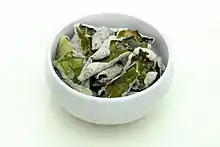Saccharina japonica
Saccharina japonica is a marine species of the Phaeophyceae (brown algae) plant, a type of kelp or seaweed, which is extensively cultivated on ropes between the seas of China, Japan and Korea.[1] It is widely eaten in East Asia.[2] A commercially important species, S. japonica is also called ma-konbu (真昆布) in Japanese, dasima (다시마) in Korean and hǎidài (海带) in Chinese.[2] Large harvests are produced by rope cultivation which is a simple method of growing seaweeds by attaching them to floating ropes in the ocean.[1][3]
| Saccharina japonica | |
|---|---|
 | |
| Scientific classification | |
| Clade: | SAR |
| Phylum: | Ochrophyta |
| Class: | Phaeophyceae |
| Order: | Laminariales |
| Family: | Laminariaceae |
| Genus: | Saccharina |
| Species: | S. japonica |
| Binomial name | |
| Saccharina japonica (J.E. Areschoug) C.E. Lane, C. Mayes, Druehl & G.W. Saunders | |
| Synonyms | |
|
Laminaria japonica J.E. Areschoug | |
The species has been cultivated in China, Japan, Korea, Russia and France.[4] It is one of the two most consumed species of kelp in China and Japan.[1] Saccharina japonica is also used for the production of alginates, with China producing up to ten thousand tons of the product each year.[5]
Consuming excessive S. japonica suppresses thyroid function.[6]
Nomenclature
The species was transferred to Saccharina in 2006.[7] Three synonyms for this species name are Laminaria japonica (J. E. Areschoug 1851), its variety Laminaria japonica var. ochotensis (Miyabe & Okamura 1936) and Laminaria ochotensis (Miyabe 1902).[4]
Cultivation
With the development of cultivation technology, though over 90% of Japanese kombu is cultivated mostly in Hokkaidō, production can also be found as far as south of the Seto Inland Sea.
Culinary use
Korea
In Korean cuisine, dasima is used to make broth, deep-fried into bugak or twigak (coated and uncoated fries), pickled in soy sauce as jangajji, and eaten raw as a sea vegetable for ssam (wraps).
It is also used to make dasima-cha (kelp tea).
Cheonsa-chae (kelp noodles) is made from the alginic acid from dasima.
 Raw dasima served as a ssam vegetable, with dipping sauces
Raw dasima served as a ssam vegetable, with dipping sauces Dried dasima for broth
Dried dasima for broth Dasima-bugak (deep-fried kelp snack)
Dasima-bugak (deep-fried kelp snack) Cheonsa-chae (kelp noodles)
Cheonsa-chae (kelp noodles)
See also
- Kombu
- Kelp tea
- Edible seaweed
- Seafood allergy
- Vitamin B12
- Kelp
- Laverbread
References
Citations
- M. D. Guiry. "Kelps: Laminaria and Saccharina". www.seaweed.ie.
- Abbott, Isabella A (1989). "Food and food products from seaweeds". In Lembi, Carole A.; Waaland, J. Robert (eds.). Algae and human affairs. Cambridge University Press, Phycological Society of America. p. 141. ISBN 978-0-521-32115-0.
- Laminaria seafarming in China FAO
- Guiry, M.D.; Guiry, G.M. (2008). "'Saccharina japonica'". AlgaeBase. World-wide electronic publication, National University of Ireland, Galway.
- M. D. Guiry. "Alginates". www.seaweed.ie.
- Miyai, Kiyoshi; Tokushige, Tomoyasu; Kondo, Masahiko (2008-12-01). "Suppression of thyroid function during ingestion of seaweed "Kombu" (Laminaria japonica) in normal Japanese adults". Endocrine Journal. 55 (6): 1103–1108. doi:10.1507/endocrj.k08e-125. ISSN 1348-4540. PMID 18689954.
- Lane, C.E., Mayes, C., Druehl, L.D. & Saunders, G.W. (2006). A multi-gene molecular investigation of the kelp (Laminariales, Phaeophyceae) supports substantial taxonomic re-organization. Journal of Phycology 42: 493-512.
Sources
- Davidson, Alan. Oxford Companion to Food (1999), "Kombu", p. 435. ISBN 0-19-211579-0
- Culture of Kelp (Laminaria japonica) in China
- Hosking, Richard (1996). A dictionary of Japanese food: ingredients & culture. Tuttle Publishing. pp. 206–208. ISBN 978-0-8048-2042-4.
External links
| Wikimedia Commons has media related to Saccharina japonica. |
